Log splitters are a really efficient way to save time, whether you’re preparing a fire pit, getting fuel ready for a wood-fired outdoor kitchen, or even scraping down old timber from scrubland, or clearing large sections of the garden from trees.
In this article, we’re going to explain why you need a log splitter, as well as how to save money on log splitters when you don’t need to buy the best log splitter on the market and can get away with something a little bit cheaper.
More...
Top Rated Log Splitter for 2024

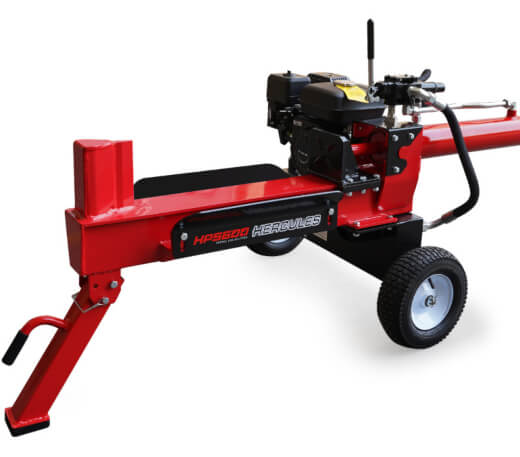
Best Log Splitters for 2024
Product | Our Rating | Price | |
|---|---|---|---|
1. BAUMR-AG 20 Ton Hydraulic Petrol Log Splitter HPS600 |  |  | |
2. Rover 33 Ton Petrol Log Splitter |  | ||
3. Rover 8 tonne 141cc Petrol Log Splitter |  | ||
4. BAUMR-AG 9 Ton Hydraulic Electric Log Splitter |  | ||
5. Yukon 240v 8 Ton Electric Hydraulic Log Splitter |  | ||
6. BE 126 LSED10T20 Electric Log Splitter | 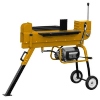 | ||
7. Estwing Sure-Split Log Splitting Wedge | 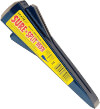 |
Tool Buyer’s Guide to Log Splitters
What is a Log Splitter?
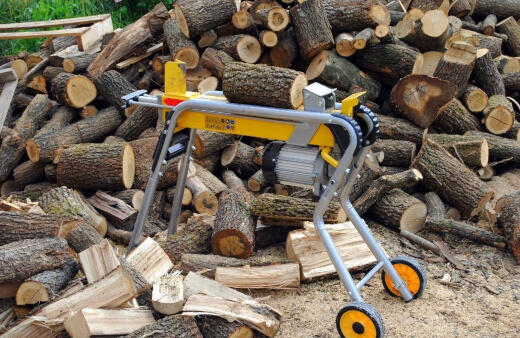
Log splitters are, as you’ve probably guessed, tools to split logs. There’s nothing particularly exciting about these tools because there doesn’t need to be.
They come in a few different forms though, so depending on the scale of the job at hand, you need to understand the difference between manual, drill, and hydraulic log splitters.
What to Look For When Buying a Log Splitter
Before thinking about what you need from a log splitter, decide what you need a log splitter for. If you need a log splitter for regular firewood, something small and convenient is probably the best choice, like a log splitter drill bit, or even a manual log splitter that can attach easily to decking, walls, or stumps to quickly break down large timbers.
But if you need a log splitter for commercial landscaping and clearance works, then you need a hydraulic log splitter. We’ll explain more about what they are, and what they can do in a second, but lastly, the third, and easiest log splitter to keep stored away is a drill bit.
You can get wedge drill bits that attach to electric drills whenever you need them online. They’re relatively inexpensive and super easy to use.
Once you’ve decided what types of drill bit you need, the next question is size, because size is everything when it comes to log splitting.
Different Types of Log Splitter
Once you’ve decided whether you need a log splitter drill bit, a hydraulic log splitter, or a log splitting wedge, you need to understand the difference within each category.
Our log splitter reviews below share some of the best log splitters to buy in 2024, but before you choose, take some time to understand the ins and outs of each type of log splitter:
Log Splitter Drill Bits

Log splitter drill bits work by forcing their way into the structures of the timber and forcing them apart with very little effort. The threaded drill bits screw in, but thanks to their increasing width, don’t feed out the cavity they create, and instead crack open logs with ease.
When you’re looking for a log splitter drill bit, they are all pretty much the same size, materials and specification but there is one crucial thing to look out for: what’s the shaft?
If your drill is a push-and-play hex drill then you need a hexagonal shaft, but for drills with adjustable chucks, you’ll need a round or a square shaft to your drill bit for optimal use.
Hydraulic Log Splitters

Hydraulic log splitters work pretty much as you’d expect them to. They are industrial tools that work through logs in no time, either turning them down to firewood or just getting them small enough to run through the wood chipper.
(See our product review and buying guide on the best wood chippers available in Australia.)
There are a few different types of hydraulic presses though, so as well as size (some can work with 65cm wide logs, and have a splitting force of 65-tonne), there’s a choice between vertical and horizontal log splitters too.
Horizontal log splitters are safer, and steadier, but have less force. Vertical hydraulic log splitters have much more force and take up less space in the yard but they are also more likely to cause accidents so need some training before use.
Log Splitting Wedge / Manual Log Splitters

The most intuitive log splitter are the old fashioned ones – the chisels and wedges that just attach to old stumps. Simply crack your logs against them and they’ll break open, but it takes time, effort, and a lot of sweat to split logs the old fashioned way in the summer sun.
How to Use a Log Splitter
Hydraulic log splitters can work with huge logs, so for the biggest log splitters, you’ll need people to help move timber around before it's split.
Most these days are electric too, so there’s no need to refuel, but for any gas-powered, log splitter, you’ll get their engines started, usually with a pull cord so they’re not completely effortless.
Once you’ve started the engine, put your logs in place (vertical or horizontal depending on the machine), start the engine with your hands well away from any moving parts, and then cut.
After each cut, replace your log and cut again until it is split down to the size you need. There’s very little practical difference in how to use a drill log splitter, or a manual log splitter, other than the engine.
Once you start splitting your log, just keep going until it is split down to the size you need for kindling or transport.
Safety Guidance for Log Splitters
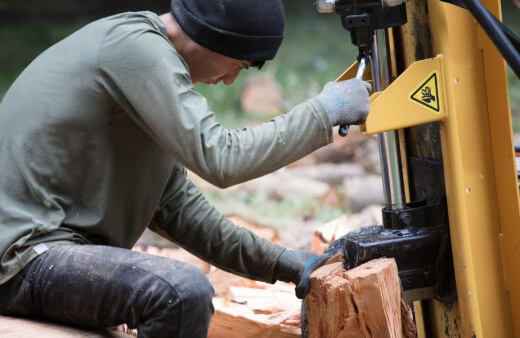
For any log splitter, make sure you’re working with a partner if you have particularly large logs to move around before splitting. Even cut logs tend to weigh 50+kg before you split them so they’re not easy to lift.
Also, make sure to wear goggles when using any log splitter. Splinters might not seem that dangerous, but shards of timber can easily separate from dry logs and it’s always worth protecting your eyes.
Safety for Hydraulic Log Splitters
Hydraulic log splitters should only ever be used on even ground. They’re heavy machines with a lot of force and should be fully secure before starting the engine.
Only ever adjust logs when you’re sure the log splitter is turned off. 65 tonnes of pressure is a lot of pressure. Check over any of the hydraulic and fuel pipes before turning the machine on.
Pinhole openings in pressured systems can tear skin and cause lasting damage. Any damage to pipework means the machine needs repairing and should not be used.
Log Splitter Reviews
1. BAUMR-AG HPS60020 Ton Hydraulic Petrol Log Splitter

BAUMR-AG HPS60020
It’s not often you’ll need to split logs over 540mm wide, so this is probably the best log splitter for professional landscapers. It’s a petrol model, which means it’s not particularly efficient, but on the plus side, you won’t need to run a generator on site which makes it a more sensible choice for professional gardeners.
It’s a horizontal log splitter, which might put more heavy-duty tree surgeons off, but provided you’re working with a partner, this horizontal log splitter is a great, fast, powerful, choice.
Pros
Cons
2. Rover 33 Ton Petrol Log Splitter
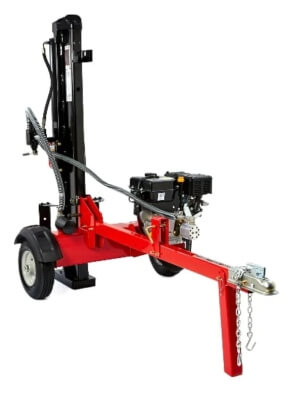
Rover 33 Ton Log Splitter
33 tons of pressure is an incredible amount of splitting force for a log splitter in this price range. It’s definitely a premium domestic model, but could easily hold its own in a commercial setting, with safety features in every part.
If you’re going to spend on a log splitter, then you could do a lot worse than this, with its horizontal AND vertical cutting positions, and the ability to split a 65cm log with ease.
Pros
Cons
3. Rover 8 tonne 141cc Petrol Log Splitter
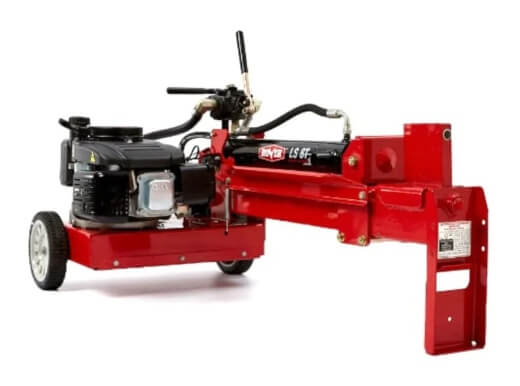
Rover 8 tonne Petrol Log Splitter
The 8-tonne splitting force isn’t nearly as much as the higher-end log splitters, but it’s enough to easily split most trunks. The real attraction of the Rover log splitter is safety. It’s one of the most powerful horizontal log splitters in its price range and is incredibly safe.
Obviously, there are standard safety considerations, but there’s no chance of tipping, and the workmanship on the welding is second to none.
Rover takes pride in their tools, and it’s really apparent with this handy log splitter.
Pros
Cons
4. BAUMR-AG 9 Ton Hydraulic Electric Log Splitter

BAUMR-AG HPS3200E
Baumr makes a massive range of log splitter, and forestry tools, so it’s no surprise that they manufacture the top end, and the budget models too, so everyone can enjoy the convenience of these great tools, even if it’s just for BBQ fuel.
The pressure of this electric model might not match up to some of Baumr’s petrol models but it does the job, and it’s easy to store or move, and quick to use too.
The Baumr electric log splitter is a great choice for commercial gardeners who aren’t regularly splitting logs, and for serious gardeners who like to be kitted out, tree surgeons will need something with more power.
Pros
Cons
5. Yukon 240v 8 Ton Electric Hydraulic Log Splitter
There are a few hydraulic log splitters on Amazon and other online marketplaces, but the best brands and most durable log splitters are from the big DIY stores and serious tools suppliers.
This is a great budget model DIY log splitter, but its uses don’t go far beyond home use, limiting it to being a useful addition to a BBQ set-up, but definitely not powerful enough for professional use.
Pros
Cons
6. BE 126 LSED10T20 Electric Log Splitter
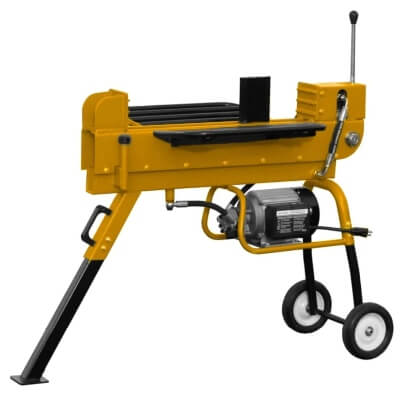
BE 126 LSED10T20
The simple log splitter from BE is great if you’re on a budget. It’s got 10 tons of splitting force, which is ideal for splitting firewood or breaking down small logs.
Its simple electric engine produces 2.5HP and connects easily to the mains. Like any domestic log splitter it’s designed for horizontal use, making accidents less likely, but also limiting the log size.
Pros
Cons
7. Estwing Sure-Split Log Splitting Wedge
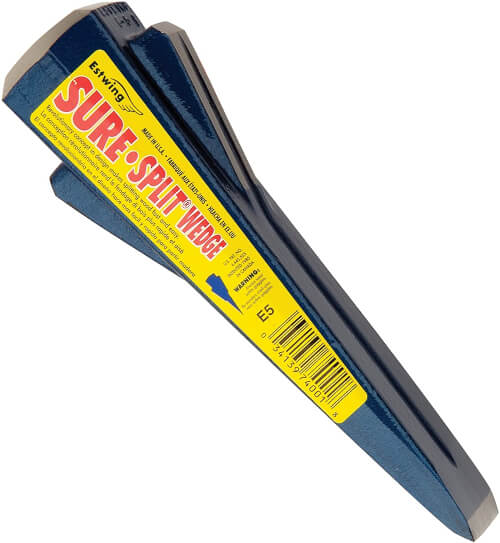
Estwing E-5
The Sure-Split log splitting wedge is a useful tool for camping, to split small pieces of dry timber, or even cutting down green wood ready for fires later in the year, but it's a lot of hard work, and you’ll need a decent sledge hammer to go with it.
The classic design relies on downward force, and you can apply good force with lump hammers, but it will take a long, long, time to work through an entire log with these old fashioned manual tools.
Pros
Cons
Best Log Splitters Australia
Top Rated Log Splitter


BAUMR-AG HPS600
The BAUMR-AG 20 Ton Hydraulic Petrol Log Splitter HPS600 is a really good bit of kit, easily capable of keeping up with professional forestry, but maybe not full tree felling.
For tree surgeons on the move, seeing to people’s garden trees, and maintaining tree health, this is more than capable of splitting down branches and small trees, and it’s petrol, so completely portable without any need for a generator on standby.
Log Splitter Frequently Asked Questions
Are log splitters worth it?
Log splitters save you time, and can even save money by managing your own supply of lumber for firewood. If you’ve ever seen the price difference between a bag of split logs and raw logs you’ll know exactly what I mean.
Splitting your own logs will save you huge amounts in the long run.
How many tons does it take to split a log?
Different timbers at different thicknesses will require greater pressure to split, but log splitters with as little as 2 tons can exert enough force to split properly dried small logs. For larger logs, you may end long splitters in the region or 20-30 tons.
Is a 22-ton log splitter big enough for 18-inch logs?
A 22-ton log splitter is enough for most household uses and will split hardwood logs up to about 18 inches wide. For softer timber, the same tonnage will usually be able to split logs up to 25 inches wide.
What side log can a 25-ton log splitter handle?
A 25-ton log splitter can split logs of around 100 LB or more depending on the type of timber. 24-25” wide logs should be suitable on most log splitters with that sort of pressure.
How long should logs sit before splitting?
Logs should be left to cure for at least six months before splitting for firewood. They will split easier and with less force once they have cured properly, saving you time and effort, and potentially money on repairs from misusing your log splitter on wet logs.
Is it easier to split wet or dry logs?
It is much, much easier to split dry logs. While dry logs can splitter, wet logs cause all sorts of other health hazards by reducing the capacity of your log splitter. Wet logs are harder to split, and much less brittle. They are also heavier to move around.
What can a 5-ton log splitter split?
A 5-ton log splitter can split softwood up to about 10” across. 5-ton log splitters are designed for the fast and efficient splitting of small timber, usually in home settings, and are not suitable for commercial work.
Do cheap log splitters work?
Cheap log splitters can work perfectly well in the right hands, but you’ll need to set them up on the level ground and make sure they are never used above capacity. The biggest problem with cheap log splitters isn’t the force they exert, it’s their stability with heavier logs.
What is the fastest way to split logs for firewood?
Pneumatic log splitters are more efficient than traditional log splitters but if you’re at home without a large splitter, you can use any steel wedge or a small axe to split smaller timber into kindling.
How many tons do you need to split oak?
Oak is a particularly hard timber to split, and if you’ve got a full trunk of 1-2-foot wide branch, you’ll need a log splitter with at least 30 tons of force to safely split oak logs.
How big should I split my firewood?
Firewood is best split into a mix of sizes; some smaller pieces, about 1 inch across for kindling, and a few 3-4 inch logs for longer burning times. If you’re burning logs in an open fire with coal or smokeless fuels, you should only need kindling so split logs right down to 1-2” across.
How do you season firewood quickly?
After the initial drying phase, firewood should be split with a log splitter into 4-5” wide pieces. Those pieces will then need a little extra time to cure before they are ready to burn without splitting or sizzling.
How much pressure does it take to spit a log?
It takes around 600kg of pressure to split a log, which is the weight of an adult bear, and considering that pressure needs to be targeted too, it’s pretty essential you use the right tools for the job, and don’t try splitting large logs without the proper equipment.
Is a vertical or horizontal log splitter better?
Vertical log splitters are better for splitting large logs, as they mean you don’t need to lift them onto the spitting track. However, horizontal splitters are generally safer to use, so for smaller logs, a horizontal splitter is better (and cheaper), and for large logs, you’ll need a vertical log splitter.
Is it easier to split green wood or dry wood?
It’s much easier to split green wood than dry wood as the fibres are easier to split apart when they are still wet. It is also more convenient and helps timber to cure for firewood faster by creating a greater surface area after splitting, than curing entire logs until they’re dry.
Get the Best Log Splitter for Your Needs
Log splitters might not be your average backyard tool, but for commercial landscapers, they’re going to save you a lot of time and effort and time is money. For tree surgeons, they are pretty much an essential piece of kit because even the most powerful portable wood chipper can’t break down full trunks.
We always try to bring you the best landscaping advice we can in our reviews, along with finding the best tools for the job, because we’re passionate about plant and landscape management, so we hope we’ve helped you find the best log splitters, and hope you have many years of successful woodland management to come.

Published on January 26, 2023 by Gary Clarke
Last Updated on January 12, 2024





